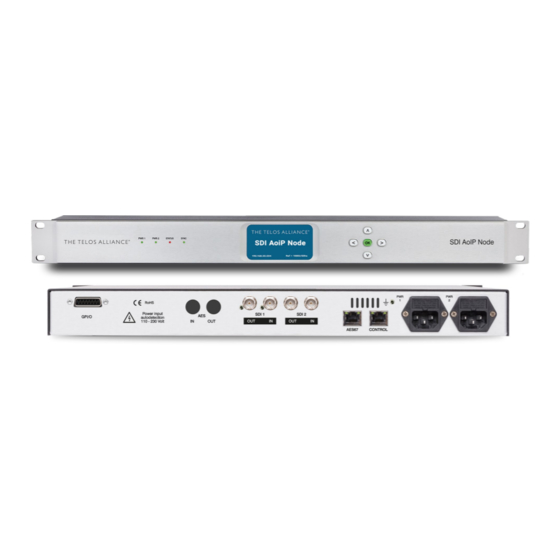
Advertisement
QUICK-START INSTALLATION GUIDE
Telos Alliance
SDI AoIP Node
®
Bridging the Present and Future of TV Technology
Introduction
Congratulations on your purchase of SDI AoIP Node. We know that you're anxious to get started, so this
quick start guide (QSG) will take you from 'out of the box' to 'up and running' as quickly as possible by
illustrating the steps required to prepare the SDI AoIP Node to de-embed and convert up to 8 pairs of
audio from two SDI inputs to AES67.
Plug each of the SDI AoIP Node's two power supplies into two different AC power circuits.
Plug an Ethernet cable from your network into the Control Ethernet port.
See Figure 1.
Figure 1 - SDI AoIP Node Rear Panel
Advertisement
Table of Contents

Summary of Contents for Telos Alliance SDI AoIP Node
- Page 1 (QSG) will take you from ‘out of the box’ to ‘up and running’ as quickly as possible by illustrating the steps required to prepare the SDI AoIP Node to de-embed and convert up to 8 pairs of audio from two SDI inputs to AES67.
- Page 2 When the unit is ready, the front panel display will light up as shown in Figure 2 below Figure 2 - SDI AoIP Node display and navigation To the right of the display there are four navigation buttons – Left, Right, Up, and Down - and an OK button.
- Page 3 SDI AoIP Node Using a Browser The user interface to the SDI AoIP Node uses an HTML 5 web browser on any platform. Firefox and Chrome are both recommended. Using any computer on the same network and subnet as SDI AoIP Node, enter the SDI AoIP Node’s IP address as shown below.
- Page 4 AES67/PTP. The Reference Clock indicator will show AES67/PTP as the primary clock source and a green light will indicate the SDI AoIP Node is locked to the PTP Master. A secondary sync source can be selected is desired. The internal clock is selected in the example. See Figure 6.
- Page 5 Figure 8 - AES67 Multicast Addresses Selecting “Delays” under I/O allows you to set the video delay equal to the SDI AoIP Node’s audio latency. In intances where the SDI output needs to be delayed by an even frame, the video delay can be set to 1 full frame and the audio delay then increased to make unit’s latency plus any additional delay equal to one...
- Page 6 QUICK-START INSTALLATION GUIDE This Page Intentionally Left Blank...
- Page 7 QUICK-START INSTALLATION GUIDE This Page Intentionally Left Blank...
- Page 8 LinkedIn: /TelosAlliance YouTube: TelosAllianceTV Google+: +TelosAlliance Product Catalog TelosAlliance.com/now 1241 Superior Ave. • Cleveland, Ohio, 44114, USA • +1.216.241.7225 • TelosAlliance.com © 2019 TLS Corp. The Telos Alliance®. All Rights Reserved. C19/19090 PN: 1490-00215-001 --- QUICK START GUIDE: SDI AoIP Node...




Need help?
Do you have a question about the SDI AoIP Node and is the answer not in the manual?
Questions and answers